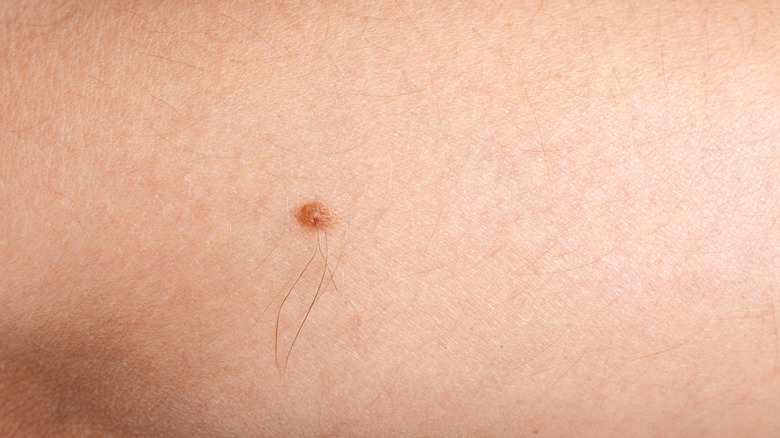What It Means When Your Mole Grows A Hair
Even if we didn't know the scientific definition of a mole, we've all seen one, either on ourselves or on someone else. People typically get moles during childhood, but it is possible for you to develop one when you're an adult too. Moles are a group of skin cells (also known as melanocytes) that can appear anywhere on your skin, per board-certified dermatologist, Dr. Paul Curtiss (via Well+Good). "Melanocytes are normally distributed throughout our skin, and impart its natural pigment [melanin]," added the skin specialist. Moles are most commonly benign in nature. They can appear anywhere — face, back, arms, legs, scalp, armpits, under your nails, etc.
It is not unusual for some moles to grow hair. In fact, some experts think that this just means the cluster of skin cells that make up the mole is simply sitting on an area that has a hair follicle. Moles on certain locations of your body, like ones on hair follicles, may even grow rougher or darker hair, because of the concentration of melanin-producing melanocytes, per Director of Cosmetic and Clinical Research at the Mount Sinai Hospital in New York City, Dr. Joshua Zeichner (via Shape).
If you've experienced this, you're probably in the habit of trying to remove these hairs, simply because they keep coming back. Or perhaps you're dealing with multiple dark and thick hairs sprouting out of your mole. Science may have a different explanation for this too. Let's get into it.
Moles could be promoting hair growth
Experts have another theory about what a hairy mole might mean. According to a 2023 study published in the journal Nature, moles could be promoting hair growth. Led by professor of developmental and cell biology at University of California, Irvine, Maksim Plikus, the research tried and succeeded in stimulating hair growth in mice, using a molecule found in hairy human skin moles.
The molecule in question is called osteopontin. It is found in a cluster of melanocytes that also have hairs growing out of them, and it has a regenerative effect on dormant hair follicles, which in turn stimulates hair growth, per the researchers. Plikus actually thinks this finding can go a long way in combating hair loss in people. "Your pre-existing dormant hair follicles will awaken and they will start growing again. Once they start growing, they will naturally produce hair that has qualities that you kind of remember when you were 18. It will be the same thickness, length. It will be straight or curly," explained Plikus (via NBC News).
Going back to moles, however, a common concern with them is whether or not they are cancerous. Hair growing out of them can ring alarm bells for some, but experts don't think a hairy mole signals disease — unless of course it comes with other changes.
When is a hairy mole a sign of cancer?
Your mole doesn't have to be a hairy one for you to keep an eye out for changes. Moles can be congenital (meaning we have them from birth), acquired, or atypical. While typically, a mole would be round or oval shaped, flat or slightly raised, have a symmetrical border, be no wider than 5 millimeters, and uniform in color (brown, tan, red, pink, blue, flesh-hued, or clear), atypical moles have varying colors, textures, and shapes.
Speaking of varying colors and textures, if you notice that your mole has grown in size, has an irregular shape, or has changed color (either completely or in some spots), then it might mean it's time to become concerned about your mole. Other signs to watch out for include bleeding or oozing from the mole. Since it is always best to be safe than sorry, new moles during adulthood or existing moles that changed in the ways we listed, are better checked out by your dermatologist. This becomes increasingly important for people with a family history of skin cancer (melanoma).
Cancer worries aside, however, if you're simply worried about how to remove the hair from these dark spots, the nature of your mole might give you a clue. While you can use a razor or wax over flat moles, shaving a raised mole is a common hair removal mistake you should avoid — chances are you're going to injure the area. Laser hair removal is also not recommended for fear of residual hyperpigmentation.



